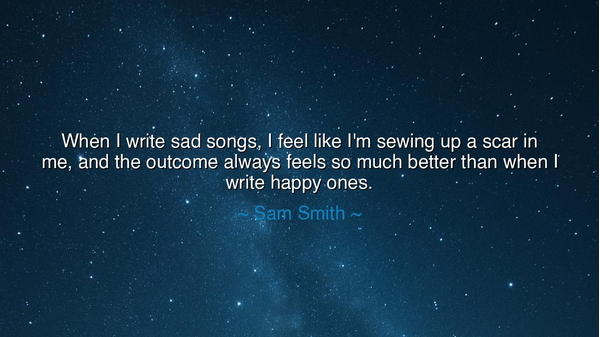
When I write sad songs, I feel like I'm sewing up a scar in me
When I write sad songs, I feel like I'm sewing up a scar in me, and the outcome always feels so much better than when I write happy ones.






There is a sacred power in pain transformed into art. In the words of Sam Smith, “When I write sad songs, I feel like I'm sewing up a scar in me, and the outcome always feels so much better than when I write happy ones.” These are not merely the musings of a musician—they are the confession of a soul that has learned to turn sorrow into healing. Smith speaks of music not as entertainment, but as medicine, as a ritual of stitching together the torn fabric of the heart. In every note of melancholy, there is both suffering and salvation, and through creation, grief is given shape, voice, and ultimately, peace.
The image of “sewing up a scar” is ancient and profound. A scar is what remains after pain has done its work; it is proof that one has endured. But even scars ache, and sometimes they need tending—not with bandages, but with understanding. To write a sad song is to reopen the wound, not to suffer again, but to cleanse it, to give meaning to what once felt meaningless. Just as the healer of old would draw out the poison before closing the wound, so too does the artist draw out the sorrow before turning it into beauty.
Sam Smith’s confession belongs to a lineage of creators who have done the same. Beethoven, in his deafness, wrote the Moonlight Sonata, a work that sounds like mourning made divine. Frida Kahlo, trapped in her body’s agony, painted self-portraits that turned pain into immortality. These artists, like Smith, remind us that art born from sadness carries a depth that joy alone cannot reach. It is not that happiness is unworthy, but that sorrow digs deeper—it reaches the roots of our humanity, where the soul learns compassion, resilience, and truth.
The ancients knew this well. In Greek tragedy, audiences wept not to wallow in despair, but to experience catharsis, the cleansing of emotion through art. The poet or playwright who bared his suffering did so to heal both himself and those who listened. Sam Smith’s sad songs are modern echoes of that same timeless practice—a way of saying, “I hurt, and in sharing it, I am made whole.” There is strength in vulnerability, and courage in turning tears into melody.
And there is a mystery in why sadness often feels more healing than joy. Happiness, fleeting and golden, lifts us for a moment—but sorrow, when faced with honesty, grounds us, humbles us, and connects us to every living soul that has ever loved and lost. When Smith says the outcome feels better, he means that sorrow refined through song becomes understanding. It is no longer a weight, but a wisdom. The heart that once broke learns its own resilience through the act of creation.
Consider the story of Vincent van Gogh, who painted the night sky not as it appeared, but as it felt—a whirl of turmoil and transcendence. His Starry Night was painted during his deepest despair, yet it remains one of the most uplifting images in art. He too was sewing up his scars, not with thread or words, but with color and motion. From his sorrow came illumination, proof that beauty can be born from the darkest of nights.
Sam Smith’s words teach us that pain need not destroy—it can transform. Each of us carries scars invisible to the eye, memories of loss, betrayal, loneliness, or longing. Yet when we give those feelings expression—whether in writing, painting, song, or speech—we cease to be victims of them. We become their authors. Through creation, we reclaim ownership of our suffering and turn it into strength. This is how the wounded become healers.
So let the lesson be this: when pain visits you, do not silence it. Shape it. Speak it. Sing it. For in doing so, you do not feed sorrow—you free it. Like Sam Smith, learn to sew your own scars with the threads of art and truth. When the work is done, you will find that the wound no longer bleeds; it glows. And in that glow lies the eternal promise—that from sadness, the most enduring forms of beauty are born.






AAdministratorAdministrator
Welcome, honored guests. Please leave a comment, we will respond soon